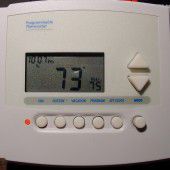[Blog] How the U.S. Department of Energys Home Energy Score Uses HPXML
Energy Disrupter

The Energy Department recognizes the value that data standards and systems bring to the world of building energy efficiency. As such, its Building Technologies Office (BTO) has helped fund a variety of resources for commercial and residential building energy sectors to increase knowledge and value for energy efficiency – including national data standard, HPXML. Standardizing data languages and field formats is fundamental for programs large and small to make the best use of their time and resources, ultimately allowing for more resources to flow to homeowners and residents through efficiency upgrades.
Home Energy Score and HPXML
Imagine you want to implement a coordinated strategy to save energy and money for homeowners across a region. To do this, you need some pieces of data from energy efficiency contractors to know where you are starting, how money is being spent through home efficiency projects, and estimated savings from these projects. In a world without HPXML, it’s as if some contractors are delivering this information over the phone in Japanese, some via email in French, and others in letter format in Afrikaans. All the data and information may be true in its own right, but this system takes significant time and resources for translation, integration, decoding, and comparing data field definition nuances.
No one has time for all the inefficiencies and costs of this data white noise. Millions of homes across the U.S. – which make up roughly 95% of our building stock infrastructure – are in desperate need of upgrades to make them more affordable, comfortable, and healthier places to live.
Millions of families struggle to pay energy bills every month. One FDIC survey found utility bills to be the most commonly reported reason borrowers pursued predatory payday loans. According to the U.S. Energy Information Administration (EIA), nearly one in three U.S. households experienced energy insecure situations in 2015. Residential buildings have overtaken the commercial buildings sector in terms of overall energy use at around 11 Quads. Although residential buildings make up about 22% of overall U.S. energy demand, some data suggests they have a disproportionate impact on peak demand: analysis of ERCOT data from Texas shows the residential sector comprises about 50% of annual summer and winter peak demand.
In order to meet national goals for a healthier population with affordable energy bills and a cleaner environment, residential efficiency programs need to be efficient, cost-effective, and scalable. HPXML and Home Energy Score are both DOE-funded initiatives working to make this vision possible.
Although Home Energy Score was initially designed, tested, and field-validated before the development of HPXML, these efforts are in fact complementary. We worked with the National Renewable Energy Laboratory (NREL) to develop an HPXML translator to Home Energy Score, which allows for HPXML-compliant software to easily become API-compliant with Home Energy Score. This has essentially created two viable Home Energy Score API-compliance pathways, enabling more software providers than ever before to offer Home Energy Scores as a standard component of energy assessments.
Beyond data standardization, Home Energy Score also enables standard building energy models to reach the hands of U.S. consumers. While HPXML helps make sure the information flowing into the tool is standardized, Home Energy Score interprets that information in a consistent way using best available data analysis resources.
Home Energy Score is like a miles-per-gallon rating: it creates an energy model based on energy asset features and estimates how much energy a home is likely to use in a year under standard operating conditions. The tool allows efficiency features to be accounted for and consolidated into a few holistic metrics that convey estimated energy use, costs, emissions, and potential upgrades. These metrics then allow homes to be compared across a market, making energy efficiency information available for real estate listings, home appraisals, mortgage financing, and more. Because the Score reflects estimated annual energy costs, this information can be used to assess adjustments for a homeowner’s expected total homeownership costs and income cash flows. Standard information that can be incorporated into real estate and financing systems is vital for increasing demand for residential efficiency upgrades.
Why does a standard metric like Home Energy Score matter? Energy use is a confusing subject for most Americans because total energy use relies on many contributing factors. These factors are best handled “under the hood” to deliver concise, meaningful information to consumers. Not only is energy efficiency persistently undervalued in the market, it is also consistently misunderstood and inappropriately valued by asymmetric information in the marketplace.
Imagine if when comparing cars for purchase, one window sticker said it performs at 20 miles per gallon, while another car’s label says it has the most energy-efficient radio on the market and uses some recycled materials. This information is not comparable and leaves out too much information for efficiency to be appropriately attributed and valued. Yet, this is how we expect consumers to make decisions about a home’s “green features” in the real estate market – leaving it to the homebuyer to consider how an “efficient furnace”, “an air conditioner with SEER 16”, “double pane windows”, and “bamboo floors” reflect a home’s energy performance. This has left consumers confused and real estate data aggregators unable to understand how efficiency influences loan performance and other factors.
HPXML ensures contractors can collect their data in the field and cost-efficiently transfer it to efficiency program administrators. Home Energy Score puts that data to work by delivering meaning and value to consumers and lenders in the moments that matter most.
Highlights from the Field: Home Energy Score Around the Country
In Portland, OR, Home Energy Score is playing an increasingly important role in the real estate market. Since homes listed for sale in the city must include a Home Energy Score report, homebuyers are now armed with valuable information about the homes they’re looking at – not only are they made aware of a home’s Score and estimated energy costs, but also what they can do to make the home more efficient and comfortable to live in. And now local lenders in Portland are making it easier for homebuyers to finance the cost of energy improvements with their mortgages through Fannie Mae’s HomeStyle Energy Mortgage and Freddie Mac’s GreenCHOICE Mortgage.
In Massachusetts, the award-winning Mass Save program now requires all participating utilities to generate a comparable scorecard along with every home energy assessment, and they will soon be using Home Energy Score as the modeling engine for that scorecard that will reach between 60,000-80,000 homes each year. Tapping into this nationally standardized and weather-normalizing tool will enable the state to provide consistent home energy information to residents and will prime them to include their Home Energy Score in real estate listings if they make upgrades.
With a seamless system to translate HPXML data into Home Energy Score data inputs, home performance contractors can tap into a nationally standardized tool to generate consistent home energy information anywhere in the country. For more information on the U.S. Department of Energy’s Home Energy Score, visit www.homeenergyscore.gov.

















